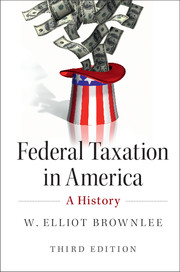Book contents
- Frontmatter
- Dedication
- Contents
- Figures
- Preface
- Acknowledgments
- 1 Anglo-American Regimes
- 2 Creating a Modern Fiscal State
- 3 The Civil War Regime
- 4 The World War I Regime
- 5 Roosevelt's Regimes
- 6 The Era of Easy Finance
- 7 “Reagan Revolution”
- 8 Fiscal Consolidation and Revival of the Old Tax Regime
- 9 Victory for a Retro-Liberal Regime
- 10 Fiscal Paralysis
- Appendix
- Historiography and Bibliography
- Index
8 - Fiscal Consolidation and Revival of the Old Tax Regime
Published online by Cambridge University Press: 05 July 2016
- Frontmatter
- Dedication
- Contents
- Figures
- Preface
- Acknowledgments
- 1 Anglo-American Regimes
- 2 Creating a Modern Fiscal State
- 3 The Civil War Regime
- 4 The World War I Regime
- 5 Roosevelt's Regimes
- 6 The Era of Easy Finance
- 7 “Reagan Revolution”
- 8 Fiscal Consolidation and Revival of the Old Tax Regime
- 9 Victory for a Retro-Liberal Regime
- 10 Fiscal Paralysis
- Appendix
- Historiography and Bibliography
- Index
Summary
The shifts in fiscal policy during the mid-1980s suggested that the United States might have the political capacity to embrace a new tax regime. The tax increases of 1982 and 1984, the Social Security reforms of 1983, and the Tax Reform Act of 1986 (which accepted the principle that tax reductions should be offset by tax increases) all reflected the kind of political leadership and discipline that were required for fundamental fiscal reform.
Significant reform, however, stalled after the passage of the Tax Reform Act of 1986. In particular, reform along the base-broadening lines chartered by the bipartisan architects of the 1986 legislation failed to advance. The essential reason was the growing popular hostility to government. The antigovernment movement that gathered force during the late 1970s and the 1980s grew even stronger in the 1990s, enabling the Republican Party to capture both houses of Congress in 1994, the first time the party had done so since 1952. This movement, with its popular base in an increasingly alienated middle class, caused politicians to fear recommending the elimination of tax expenditures, such as the home mortgage deduction, that favored large segments of society. Instead they proposed tax cuts that favored, or seemed to favor, the middle class. And the growing fervor of the antigovernment movement gave political cover to the representatives of wealthy and corporate interests who desired further cuts in taxes on capital income. The most vigorous antigovernment activists increasingly invoked retro-liberal ideology and harkened back to Reagan's tax cut of 1981 as their model for sound fiscal policy.
The antigovernment movement, however, did not produce any tax cuts on the scale of the Economic Recovery Tax Act (ERTA) during the administrations of both George H. W. Bush and Bill Clinton. These administrations at times recommended significant tax cuts, but they were much smaller than those under ERTA, some emphasized benefits to middle-class taxpayers, and most failed to win adoption. Moreover, both the Bush and Clinton administrations succeeded in enacting increases in taxes, especially in those paid by the rich, as the central elements in their projects of deficit and debt control (often referred to today as fiscal consolidation).
- Type
- Chapter
- Information
- Federal Taxation in AmericaA History, pp. 210 - 244Publisher: Cambridge University PressPrint publication year: 2016



